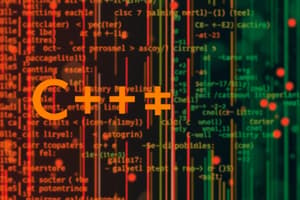Podcast
Questions and Answers
What must every C++ program include?
What must every C++ program include?
- An include directive
- A function named start
- A return statement
- A function named main (correct)
What is the purpose of a namespace in C++?
What is the purpose of a namespace in C++?
- To declare data types
- To manage memory allocation
- To store global variables
- To hold a grouping of unique entities (correct)
Which of the following is the correct way to end a statement in C++?
Which of the following is the correct way to end a statement in C++?
- With a semicolon; (correct)
- With a comma,
- With a period.
- With an exclamation mark!
What does the return statement signify in a function?
What does the return statement signify in a function?
How are strings represented in C++?
How are strings represented in C++?
What is the role of comments in C++ code?
What is the role of comments in C++ code?
What does the zero in the return statement generally indicate?
What does the zero in the return statement generally indicate?
What type of comments can be used in C++?
What type of comments can be used in C++?
What is a key characteristic of C++ variables?
What is a key characteristic of C++ variables?
Which of the following is NOT a reserved word in C++?
Which of the following is NOT a reserved word in C++?
What is the result when converting a float value of 100.25 to an integer?
What is the result when converting a float value of 100.25 to an integer?
What must variable names in C++ begin with?
What must variable names in C++ begin with?
What is the length of the string 'Hello World20 ?'?
What is the length of the string 'Hello World20 ?'?
When an integer is converted to a float, what is the expected result?
When an integer is converted to a float, what is the expected result?
How does the assignment operator function in C++?
How does the assignment operator function in C++?
In C++, what is the first position index of a string characterized as?
In C++, what is the first position index of a string characterized as?
What is the significance of case sensitivity in C++ variable names?
What is the significance of case sensitivity in C++ variable names?
What occurs if you try to convert a float value of 100.75 to an integer?
What occurs if you try to convert a float value of 100.75 to an integer?
Which of the following is a legal variable name in C++?
Which of the following is a legal variable name in C++?
Which is true about predefined identifiers in C++?
Which is true about predefined identifiers in C++?
What will happen with the statement 'Counter = 1;' in C++?
What will happen with the statement 'Counter = 1;' in C++?
Which of the following is NOT classified as an integral data type in C++?
Which of the following is NOT classified as an integral data type in C++?
What is the primary function of the bool data type in C++?
What is the primary function of the bool data type in C++?
Which of these statements regarding the char data type is true?
Which of these statements regarding the char data type is true?
How many categories of simple data types are there in C++?
How many categories of simple data types are there in C++?
Which of the following is a characteristic of integral data types in C++?
Which of the following is a characteristic of integral data types in C++?
Which of the following represents a valid integer value in C++?
Which of the following represents a valid integer value in C++?
In which situation would you use an enumeration type in C++?
In which situation would you use an enumeration type in C++?
What should be used to enclose characters when using the char data type in C++?
What should be used to enclose characters when using the char data type in C++?
What is the maximum number of characters ASCII can represent?
What is the maximum number of characters ASCII can represent?
Which statement about floating-point types is correct?
Which statement about floating-point types is correct?
Which of the following values can be assigned to a char type in C++?
Which of the following values can be assigned to a char type in C++?
What is the range of values for a float type in C++?
What is the range of values for a float type in C++?
How does the precision of a double compare to that of a float?
How does the precision of a double compare to that of a float?
What is true about the scientific notation in C++?
What is true about the scientific notation in C++?
Which of the following data types are considered the same in modern compilers?
Which of the following data types are considered the same in modern compilers?
What character representation does the number 65 correspond to in ASCII?
What character representation does the number 65 correspond to in ASCII?
Flashcards are hidden until you start studying
Study Notes
C++ Programming Basics
- In C++, all elements of the standard library are declared within the
stdnamespace. - A namespace is a logical container for grouping unique entities (blocks).
- Every C++ program MUST have a function named
main. - The body of a function starts with an opening brace (
{) and ends with a closing brace (}). - Each instruction in C++ must end with a semicolon (
;). - The
coutobject is used to display output on the screen. - Strings (text) in C++ are enclosed in double quotes (
"). - The
returnstatement ends function execution. - Returning a zero value from
mainindicates that the program executed successfully.
Data Types and Variables
- Comments are for human readers and are ignored by the compiler.
- They are used to explain code functionality, variables, functions, authorship, and development dates.
- Single-line comments start with
//. - Multi-line comments start with
/*and end with*/.
- Reserved Words (Keywords) are words that have special meaning in C++ and cannot be used as variable names.
- Examples include:
int,float,double,char,const,void,return.
- Examples include:
- Variables are containers that store the results of C++ operations, allowing them to be used in other operations.
- Variable Identifiers are names for variables.
- They consist of letters, digits, and underscores (
_). - They must start with a letter or an underscore.
- C++ is case-sensitive, meaning
NUMBERandnumberare different. coutandcinare two predefined identifiers. You can technically redefine them, but it is generally not recommended.
- They consist of letters, digits, and underscores (
- Variable Declaration is how a variable is created.
- It defines the variable's name and type.
- The format is:
type variableName;(for example:int myVariable;) - You can declare multiple variables of the same type with commas:
int variable1, variable2, variable3;
- Variable Assignment is how a variable is given an initial value.
- The assignment operator
=is used. - Examples:
Counter = 1;(assigns 1 to the variableCounter)Result = 100 + 200;(assigns the result of the sum to the variableResult)X = X + 1;(increments the value ofXby 1)
- The assignment operator
- Data Types define the kind of values a variable can hold and the operations that can be performed on them.
- Simple Data Types are basic data types that represent fundamental values:
- Integral (integers, whole numbers):
char,short,int,long,bool. - Floating-Point (decimal numbers):
float,double. - Enumeration Type: User-defined data type used to create a set of named constants.
- Integral (integers, whole numbers):
- Integral Data Types categorize integers:
char: single character (e.g., 'A', 'a', '0', '*', '+', '$', '&', ' ').short: small integer values.int: standard integer values.long: large integer values.bool: logical values (eithertrueorfalse).unsigned char,unsigned short,unsigned int,unsigned long: versions of the integral types that allow only non-negative values (0 or positive).
intData Type can represent positive or negative integers, without decimals.- Examples:
-6728,0,78,+763.
- Examples:
boolData Type represents logical (Boolean) values:trueorfalse.
charData Type is used for single characters, including letters, digits, and special symbols.- Each character is enclosed in single quotes (e.g.,
'A','*'). - A blank space is considered a character (
' '). charis the smallest integral type.
- Each character is enclosed in single quotes (e.g.,
- ASCII (American Standard Code for Information Interchange) is a standard coding system used almost universally.
- It assigns numerical values to characters (0 to 255), allowing computers to represent and process text.
- Each character has a unique ASCII code.
- The ASCII table displays these character codes.
- UNICODE is a newer coding system that expands ASCII.
- It supports a much wider range of characters, including those used in various languages around the world.
- ASCII Table is a standardized representation of ASCII codes where each character corresponds to a specific number.
charvalues areintvalues, meaning you can assign integer values to variables of typechar.- Floating-Point Types represent decimal numbers:
floatcan handle a wide range of numbers but has lower precision thandouble.doubleprovides more precise representations of decimal numbers.
floatPrecision: Limited to 6 or 7 significant digits.doublePrecision: Up to 15 significant digits.- Scientific Notation is a way to express very large or very small numbers:
3000000003E86.62607 X 10-346.62607E-34
- Conversion Between
intandfloat:- You can always convert an integer (
int) to a floating-point number (float) without losing accuracy. - Converting a floating-point number to an integer can result in loss of precision.
- You can always convert an integer (
stringData Type is used for sequences of characters.- It can be empty, containing no characters (null).
- Each character within a
stringhas a position (starting from 0). - The
string's length is the number of characters it contains. - Example:
string x = “Hello World20 ?”;// length is 15 characters.
Studying That Suits You
Use AI to generate personalized quizzes and flashcards to suit your learning preferences.




